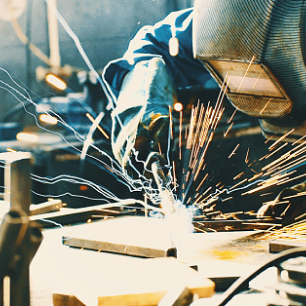Jump to:
New AWS Specifications for Torch and Furnace Soldering and Soldered Joint Mechanical Testing
When soldering technology is mentioned, it is often associated with electronics applications, such as assembling components like capacitors, resistors, and microprocessors onto printed circuit boards. These applications range from consumer electronics, such as laptops and smartphones, to high-reliability military, space, and satellite systems. In electronics assemblies, soldered joint quality is controlled by American National Standards Institute standards developed primarily through IPC International and various organizations that once comprised the Electronics Industries Alliance. Additional specifications, such as IPC J-STD-006, Requirements for Electronic Grade Solder Alloys and Fluxed and Non-Fluxed Solid Solders for Electronic Soldering Applications, also set requirements for the composition of soldering filler metals.
As it is utilized in structural applications, soldering technology does not enjoy the same breadth of standards. Soldering filler metal compositions are typically cited from ASTM B32, Standard Specification for Solder Metal, and ASTM B907, Standard Specification for Zinc, Tin and Cadmium Base Alloys Used as Solders. The International Organization for Standardization (ISO) has a similar standard: ISO 9453, Soft solder alloys — Chemical compositions and forms. Aside from these documents, process-oriented standards such as those currently available in the brazing industry have not been developed for structural soldering applications.
Advancing Process-Based Specifications for Soldering
AWS has initiated an effort to fill the standards gap through the creation of specifications that address soldering processes. This work began in 2008 with the introduction of AWS B2.3/B2.3M, Specification for Soldering Procedure and Performance Qualification. That standard was the work of the B2E Subcommittee on Soldering Qualification, which is under the auspices of the B2 Committee on Procedure and Performance Qualification. While the template for the AWS B2.3 standard was its companion document for brazing (AWS B2.2/B2.2M, Specification for Brazing Procedure and Performance Qualification), the details were tailored specifically to soldering technology.
The AWS effort on structural soldering specifications shifted to the C3 Committee on Brazing and Soldering and, more specifically, the C3B Subcommittee on Soldering. The subcommittee members concluded that the ASTM B32 standard was adequate to describe soldering filler metal compositions; therefore, no further work was deemed necessary to develop a similar AWS specification.
Instead, the subcommittee determined that the next process-based specifications should address the two most commonly used soldering techniques: torch soldering and furnace soldering. Those efforts resulted in the development of AWS C3.11M/C3.11, Specification for Torch Soldering, and AWS C3.12M/C3.12, Specification for Furnace Soldering.
Both documents include details about the materials, equipment, etc., that pertain to the respective processes. More importantly, they also cite, for the first time, structural soldered joint classifications and quality assurance requirements. The classification categories mirror those designated for braze joints at the time of publishing. The quality requirements, which address external and internal defects, are adapted to soldered joints.
Torch soldering is a subset of the general practices of hand soldering. Hand soldering also includes processes that use an electric iron, infrared heat, a flowing hot gas, or a hand-held induction coil. The C3B subcommittee developed the Guideline for Hand Soldering Practices (1st edition 2015) to provide the fundamental knowledge underlying all hand-soldering processes.
Standardizing Soldered Joint Strength Evaluation
The C3B subcommittee is excited about the newest specification currently undergoing the review process with a targeted release date in 2025. That standard is AWS C3.15M/C3.15, Standard Methods for Evaluating the Strength of Soldered Joints. The mechanical testing of soldered joints has long been a challenge for the soldering industry. Specifically, difficulties have arisen when cross comparing soldered joint strength data because different test facilities use different specimen configurations and test parameters; often, the latter is not made available with the reported strength data. Two such test parameters are displacement or strain rate and joint clearance. The strengths of tin- and indium-based solders are highly strain rate dependent. Also, joint clearance has a first-order effect on soldered joint strength, and thus, the mechanical properties of the bulk soldering filler metal cannot be used to calculate soldered joint strength.
This new standard aims to eliminate the ambiguity of soldered joint strength data by standardizing specimen geometries and testing protocols. Sample geometries are described to evaluate soldered joint strengths in tension, shear, bending moment, and peel configurations. Also contained in the specification are specimen fabrication methods, joint clearance requirements, testing parameters, and data analysis and reporting. The proposed AWS C3.15 standard does not consider those test methods for evaluating the strength of bulk soldering filler metals. The subcommittee concluded that ASTM standards for materials testing (e.g., ASTM E8/E8M, Standard Test Methods for Tension Testing of Metallic Materials) are excellent sources for those procedures. Also, bulk strength properties, obtained by ASTM methods, serve very well as input data for computational models used to predict the mechanical performance of soldered joints. This new specification will support the structural applications of soldering technology by providing a consistent and reproducible database of soldered joint mechanical test methods and strength properties.
This article was written by Paul Vianco (chair of the AWS C3B Subcommittee on Soldering and an AWS Life Member) for the American Welding Society.


